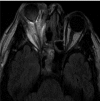Rhino-orbitocerebral mucormycosis caused by Apophysomyces elegans
- PMID: 16517873
- PMCID: PMC1393113
- DOI: 10.1128/JCM.44.3.892-898.2006
Rhino-orbitocerebral mucormycosis caused by Apophysomyces elegans
Abstract
Rhino-orbitocerebral mucormycosis (ROCM) caused by more common zygomycetes (e.g., Mucor) is known to cause rapidly fatal infections in immunocompromised patients. Apophysomyces elegans is an emerging zygomycete that has been reported to cause invasive cutaneous and rhino-orbitocerebral infections in immunocompetent individuals. Limited data exist describing the syndrome of ROCM caused by A. elegans. We describe a recent case and performed a comprehensive literature review to delineate the clinical characteristics of ROCM caused by A. elegans. Our case is a 50-year-old man with diabetes mellitus who presented with facial pain and right eye proptosis. Endoscopic sinus sampling revealed A. elegans. He was treated with liposomal amphotericin B and multiple debridements, with no disease on 1.5-year follow-up examination. Seven cases were identified on literature review, including the present case. Most patients (86%) were male, with a mean age of 40 years. Most patients (71%) did not have predisposing medical conditions. Three patients had predisposing head trauma. All presented with facial and/or periorbital pain. All had magnetic resonance imaging or computed tomography of the head showing intraorbital and/or sinus inflammation. Diagnosis was confirmed by histopathology and deep tissue culture in all cases. All patients required eye exenteration and extensive surgical debridement, in addition to intravenous amphotericin B. Six of the seven patients (86%) recovered. ROCM caused by A. elegans is rarely reported in the literature. Most such infections occurred in immunocompetent patients, often after facial trauma. Survival in ROCM caused by A. elegans is favorable in reported cases, with prompt surgical debridement and antifungal therapy.
Figures




References
-
- Blair, J. E., L. J. Fredrikson, B. A. Pockaj, and C. S. Lucaire. 2002. Locally invasive cutaneous Apophysomyces elegans infection acquired from snapdragon patch test. Mayo Clin. Proc. 77:717-720. - PubMed
-
- Brown, S. R., I. A. Shah, and M. Grinstead. 1998. Rhinocerebral mucormycosis caused by Apophysomyces elegans. Am. J. Rhinol. 12:289-292. - PubMed
-
- Burrell, S. R., D. J. Ostlie, M. Saubolle, M. Dimler, and S. D. Barbour. 1998. Apophysomyces elegans infection associated with cactus spine injury in an immunocompetent pediatric patient. Pediatr. Infect. Dis. J. 17:663-664. - PubMed
-
- Caceres, A. M., C. Sardinas, C. Marcano, R. Guevara, J. Barros, G. Bianchi, V. Rosario, R. Balza, M. Silva, M. C. Redondo, and M. Nunez. 1997. Apophysomyces elegans limb infection with a favorable outcome: case report and review. Clin. Infect. Dis. 25:331-332. - PubMed
-
- Carter, J. E., and O. Ulusarac. 2003. Widespread cutaneous involvement by invasive Apophysomyces elegans in a gravid patient following trauma. Cutis 72:221-224, 227-228. - PubMed
Publication types
MeSH terms
Substances
LinkOut - more resources
Full Text Sources
Medical

